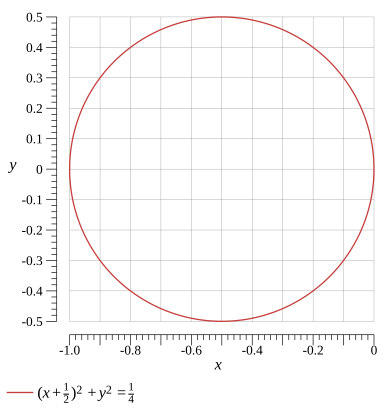Question
Identify the conic
Find the standard equation of the circle
Find the radius of the circle
Find the center of the circle
(x+21)2+y2=41
Evaluate
x2+y2+x=0
Use the commutative property to reorder the terms
x2+x+y2=0
To complete the square, the same value needs to be added to both sides
x2+x+41+y2=41
Solution
(x+21)2+y2=41
Show Solution

Solve the equation
Solve for x
Solve for y
x=2−1+1−4y2x=−21+1−4y2
Evaluate
x2+y2+x=0
Rewrite in standard form
x2+x+y2=0
Substitute a=1,b=1 and c=y2 into the quadratic formula x=2a−b±b2−4ac
x=2−1±12−4y2
1 raised to any power equals to 1
x=2−1±1−4y2
Separate the equation into 2 possible cases
x=2−1+1−4y2x=2−1−1−4y2
Solution
x=2−1+1−4y2x=−21+1−4y2
Show Solution

Testing for symmetry
Testing for symmetry about the origin
Testing for symmetry about the x-axis
Testing for symmetry about the y-axis
Not symmetry with respect to the origin
Evaluate
x2+y2+x=0
To test if the graph of x2+y2+x=0 is symmetry with respect to the origin,substitute -x for x and -y for y
(−x)2+(−y)2−x=0
Evaluate
More Steps


Evaluate
(−x)2+(−y)2−x
Rewrite the expression
x2+(−y)2−x
Rewrite the expression
x2+y2−x
x2+y2−x=0
Solution
Not symmetry with respect to the origin
Show Solution

Find the first derivative
Find the derivative with respect to x
Find the derivative with respect to y
dxdy=−2y2x+1
Calculate
x2+y2+x=0
Take the derivative of both sides
dxd(x2+y2+x)=dxd(0)
Calculate the derivative
More Steps


Evaluate
dxd(x2+y2+x)
Use differentiation rules
dxd(x2)+dxd(y2)+dxd(x)
Use dxdxn=nxn−1 to find derivative
2x+dxd(y2)+dxd(x)
Evaluate the derivative
More Steps


Evaluate
dxd(y2)
Use differentiation rules
dyd(y2)×dxdy
Use dxdxn=nxn−1 to find derivative
2ydxdy
2x+2ydxdy+dxd(x)
Use dxdxn=nxn−1 to find derivative
2x+2ydxdy+1
2x+2ydxdy+1=dxd(0)
Calculate the derivative
2x+2ydxdy+1=0
Move the expression to the right-hand side and change its sign
2ydxdy=0−(2x+1)
Subtract the terms
More Steps


Evaluate
0−(2x+1)
If a negative sign or a subtraction symbol appears outside parentheses, remove the parentheses and change the sign of every term within the parentheses
0−2x−1
Removing 0 doesn't change the value,so remove it from the expression
−2x−1
2ydxdy=−2x−1
Divide both sides
2y2ydxdy=2y−2x−1
Divide the numbers
dxdy=2y−2x−1
Solution
dxdy=−2y2x+1
Show Solution

Find the second derivative
Find the second derivative with respect to x
Find the second derivative with respect to y
dx2d2y=−4y34y2+4x2+4x+1
Calculate
x2+y2+x=0
Take the derivative of both sides
dxd(x2+y2+x)=dxd(0)
Calculate the derivative
More Steps


Evaluate
dxd(x2+y2+x)
Use differentiation rules
dxd(x2)+dxd(y2)+dxd(x)
Use dxdxn=nxn−1 to find derivative
2x+dxd(y2)+dxd(x)
Evaluate the derivative
More Steps


Evaluate
dxd(y2)
Use differentiation rules
dyd(y2)×dxdy
Use dxdxn=nxn−1 to find derivative
2ydxdy
2x+2ydxdy+dxd(x)
Use dxdxn=nxn−1 to find derivative
2x+2ydxdy+1
2x+2ydxdy+1=dxd(0)
Calculate the derivative
2x+2ydxdy+1=0
Move the expression to the right-hand side and change its sign
2ydxdy=0−(2x+1)
Subtract the terms
More Steps


Evaluate
0−(2x+1)
If a negative sign or a subtraction symbol appears outside parentheses, remove the parentheses and change the sign of every term within the parentheses
0−2x−1
Removing 0 doesn't change the value,so remove it from the expression
−2x−1
2ydxdy=−2x−1
Divide both sides
2y2ydxdy=2y−2x−1
Divide the numbers
dxdy=2y−2x−1
Use b−a=−ba=−ba to rewrite the fraction
dxdy=−2y2x+1
Take the derivative of both sides
dxd(dxdy)=dxd(−2y2x+1)
Calculate the derivative
dx2d2y=dxd(−2y2x+1)
Use differentiation rules
dx2d2y=−(2y)2dxd(2x+1)×2y−(2x+1)×dxd(2y)
Calculate the derivative
More Steps


Evaluate
dxd(2x+1)
Use differentiation rules
dxd(2x)+dxd(1)
Evaluate the derivative
2+dxd(1)
Use dxd(c)=0 to find derivative
2+0
Evaluate
2
dx2d2y=−(2y)22×2y−(2x+1)×dxd(2y)
Calculate the derivative
More Steps


Evaluate
dxd(2y)
Simplify
2×dxd(y)
Calculate
2dxdy
dx2d2y=−(2y)22×2y−(2x+1)×2dxdy
Calculate
dx2d2y=−(2y)24y−(2x+1)×2dxdy
Calculate
More Steps


Evaluate
(2x+1)×2dxdy
Apply the distributive property
2x×2dxdy+1×2dxdy
Multiply the numbers
4xdxdy+1×2dxdy
Any expression multiplied by 1 remains the same
4xdxdy+2dxdy
dx2d2y=−(2y)24y−(4xdxdy+2dxdy)
If a negative sign or a subtraction symbol appears outside parentheses, remove the parentheses and change the sign of every term within the parentheses
dx2d2y=−(2y)24y−4xdxdy−2dxdy
Calculate
More Steps


Evaluate
(2y)2
Evaluate the power
22y2
Evaluate the power
4y2
dx2d2y=−4y24y−4xdxdy−2dxdy
Calculate
dx2d2y=−2y22y−2xdxdy−dxdy
Use equation dxdy=−2y2x+1 to substitute
dx2d2y=−2y22y−2x(−2y2x+1)−(−2y2x+1)
Solution
More Steps


Calculate
−2y22y−2x(−2y2x+1)−(−2y2x+1)
Multiply
More Steps


Multiply the terms
−2x(−2y2x+1)
Any expression multiplied by 1 remains the same
2x×2y2x+1
Cancel out the common factor 2
x×y2x+1
Multiply the terms
yx(2x+1)
−2y22y+yx(2x+1)−(−2y2x+1)
Calculate the sum or difference
More Steps


Evaluate
2y+yx(2x+1)−(−2y2x+1)
Simplify
2y+yx(2x+1)+2y2x+1
Reduce fractions to a common denominator
2y2y×2y+y×2x(2x+1)×2+2y2x+1
Use the commutative property to reorder the terms
2y2y×2y+2yx(2x+1)×2+2y2x+1
Write all numerators above the common denominator
2y2y×2y+x(2x+1)×2+2x+1
Multiply the terms
2y4y2+x(2x+1)×2+2x+1
Multiply the terms
2y4y2+4x2+2x+2x+1
Add the terms
2y4y2+4x2+4x+1
−2y22y4y2+4x2+4x+1
Divide the terms
More Steps


Evaluate
2y22y4y2+4x2+4x+1
Multiply by the reciprocal
2y4y2+4x2+4x+1×2y21
Multiply the terms
2y×2y24y2+4x2+4x+1
Multiply the terms
4y34y2+4x2+4x+1
−4y34y2+4x2+4x+1
dx2d2y=−4y34y2+4x2+4x+1
Show Solution

Rewrite the equation
r=0r=−cos(θ)
Evaluate
x2+y2+x=0
To convert the equation to polar coordinates,substitute rcos(θ) for x and rsin(θ) for y
(cos(θ)×r)2+(sin(θ)×r)2+cos(θ)×r=0
Factor the expression
(cos2(θ)+sin2(θ))r2+cos(θ)×r=0
Simplify the expression
r2+cos(θ)×r=0
Factor the expression
r(r+cos(θ))=0
When the product of factors equals 0,at least one factor is 0
r=0r+cos(θ)=0
Solution
More Steps


Factor the expression
r+cos(θ)=0
Subtract the terms
r+cos(θ)−cos(θ)=0−cos(θ)
Evaluate
r=−cos(θ)
r=0r=−cos(θ)
Show Solution

Graph
